Brickyard Farm and Farfield Meadows, Wednesday 12th September
Four of us arrived at our hosts'
splendid residence in lovely September sunshine. Before any serious
investigations of their garden & fields commenced, they insisted on plying
us with tea & coffee. Our resistance was minimal; some at least did attempt
to give an impression of entomologising with one hand whilst holding their
beverage with the other!
 |
| Photograph: David Williams |
Refreshments over, our Arachnologist
produced his latest piece of equipment, a pond-net. He had his eye on the
garden pond, and the quest for a water-spider, a species, uniquely in Britain,
which makes for itself an air-filled 'diving bell' from which to sally forth
beneath the pond's surface. Much trawling with the net mainly produced copious
quantities of mud, which made finding anything else rather difficult, and no
spiders were forthcoming. After leaving the mud to settle for a while, a
strange beast did eventually appear from the murk & cause much speculation
as to its identity. Subsequently, the
author's ancient Observers Book of Pond Life identified it as an alderfly
larva, an odd-looking beast indeed.
 |
| Photograph: David Williams |
The most numerous (or at least obvious)
invertebrate in the grassland was the cranefly Tipula padulosa.
 |
| Photograph: David Williams |
Legions of
spiked shieldbugs were also enjoying the sunshine, sunbathing low in the
vegetation. Worker wasps, their colonial duties coming to an end, feasted
instead on the ripe blackberries in the hedgerows.
 |
| Photograph: David Williams |
A red kite circled lazily
over us.
Moving on into an area known as 'Seven
Acre Field', we encountered several friendly horses, who peered into our
beating trays in an interested & affable way. They deserved a photo, but
were too large for my macro lens, so sadly went unrecorded. A gorse shieldbug
was prised from a gorse bush. Feeling that lunchtime was imminent, we decided a
less horse-filled environment was called for, so moved to the next field. Here
we pitched camp next to a large dung heap before unwrapping our sandwiches.
Yum! During our visit last year, we found lesser earwigs, the money-spider
Ostearius melanopygius & various pseudoscorpions in said heap. The first
two were duly re-found and recorded, though the pseudoscorpions escaped us on
this occasion.
A wooden fence divided this field from
an adjacent, ungrazed / unmown one. Examination of this fence, which was in
full sun, produced various harvestmen and, oddly, two sunbathing walnut
orb-weaver spiders (Nuctenea umbratica). This is a strictly nocturnal species;
what it was doing sitting brazenly sunning itself is a mystery.
 |
| Photograph: David Williams |
Leaning over
the fence and sweeping the long grass with a bat-detector, a male long-winged
conehead (a bush cricket) was detected in full song.
We decided to have a brief foray into
the adjacent SWT reserve (Farfields Meadow). Sadly, it had been cut in July
& now had a flock of sheep nibbling it further, and entomological interest
was minimal. We gave up and returned to our hosts' abode, where we were further
plied with tea, coffee and biscuits, consumed whilst sitting in their lovely
garden in warm sunshine. Bliss! An examination of their flower borders revealed
various butterflies and bees nectaring on the flowers, including small copper
and painted lady, and several Halictus rubicundus, a species of solitary bee.
 |
| Halictus rubicundus & honeybee - Photograph: David Williams |
Eventually, and with some
reluctance, we forced ourselves up off the garden chairs & made our ways home.
Some other photographs from the day:
Corizus hyaoscami
 |
| Photograph: David Williams |
Dolycoris baccarum
 |
| Photograph: David Williams |
Eupeodes luniger
 |
| Photograph: David Williams |
Phalangium opilio



























No comments:
Post a Comment
Please feel free to comment on this post...